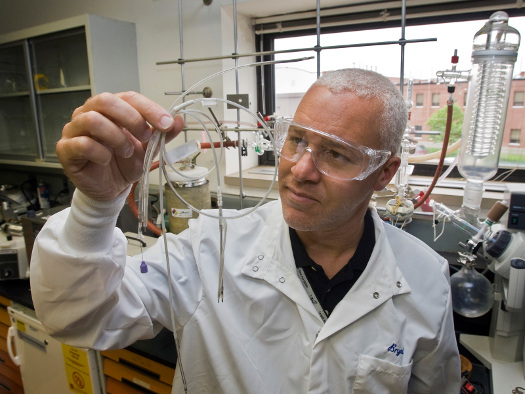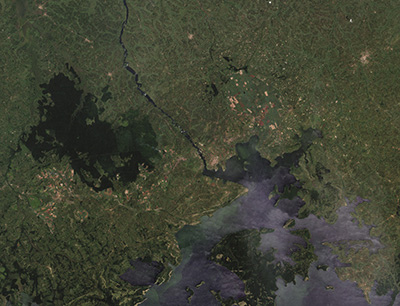 |
| May 03, 2016 | Volume 12 Issue 17 |
Designfax weekly eMagazine
Archives
Partners
Manufacturing Center
Product Spotlight
Modern Applications News
Metalworking Ideas For
Today's Job Shops
Tooling and Production
Strategies for large
metalworking plants
New Space Technology Hall of Fame inductees include medical device thermoplastic and water-hunting radar
The Space Foundation's 32nd Space Symposium ended April 14 with ceremonies celebrating the induction of two new innovations -- developed for space that now improve life on Earth -- into the Space Technology Hall of Fame.
The Space Foundation's Space Technology Hall of Fame was established in 1988 to increase public awareness of the benefits that result from space exploration programs and to encourage further innovation. Since then, 75 technologies have been inducted.
The 2016 inductees are:
- Medtronic LaRC-SI, revolutionary insulation for the treatment of heart irregularities, and
- Radar Technologies International WATEX, using satellite technology to locate water.
Medtronic LaRC-SI

Rob Bryant, a senior researcher at NASA's Langley Research Center in Hampton, VA, examines a lab model of a cardiac resynchronization therapy (CRT) device. Bryant is the inventor of a high-tech aerospace plastic called LaRC-SI that is the insulation material on one of the thinnest left-heart leads available for a CRT. [Credit: NASA/Sean Smith]
Like so many prized finds, this discovery was accidental. While at NASA Langley developing materials for high-speed civil transport and lightweight rocket bodies, Dr. Robert Bryant noticed that an experimental polymer that should have turned into a powder instead remained soluble. Others repeated his experiment with the same results.
When Dr. Bryant left the research program, there were no known applications for the material, but he continued research and developed what is now known as LaRC-SI: a durable thermoplastic readily fabricated in very thin form. The critical characteristic that lead to medical applications is that it is biologically non-reactive and solvent resistant.
Once Bryant had refined production of the compound, several NASA centers began exploring applications, including small mechanical parts, flexible circuits, advanced fiber and ceramic matrix composites, and durable coatings.
Medtronic became aware of the material and its unique qualities when LaRC-SI was recognized as an "R&D 100" award winner.
Headquartered in Dublin, Ireland, with operational headquarters in Minnesota, Medtronic is a medical device company with a core business segment focused on electrical stimulation to treat irregular heartbeats.
Medtronic was interested in replacing the insulation layer applied to leads carrying electrical impulses directly to the heart. LaRC-SI showed great promise. Convinced of the enormous benefits of this new material, Medtronic spent more than 10 years and tens of millions of dollars to secure FDA approval.
The new insulation has revolutionized the treatment of heart irregularities. The thinner, more flexible material has allowed surgeons to get electrical impulses into areas previously too difficult to reach. And the more resilient new insulation significantly reduces lead failure over time and the number of high-risk procedures to correct the problem. In short, LaRC-SI use has led to decreased mortality rates and improved quality of life for thousands of people.
Since receiving FDA approval in 2010, more than 660,000 of the new leads have been sold, and Medtronic continues research of LaRC-SI use in other medical devices.
Radar Technologies International WATEX

Radar Technologies International's (RTI) WATEX System uses Landsat data, which contains information on surface topography and rock chemistry, to help locate underground water. Here it looks at the largest of the African Great Lakes, Victoria, which is situated across Tanzania, Uganda, and Kenya. [Image credit: NASA]
Dr. Alain Gachet founded Radar Technologies International in 1999 to use satellite-generated remote-sensing data to identify probable locations of precious metals. Analyzing satellite data in pursuit of precious metals in the Libyan Desert, Dr. Gachet made a surprising discovery. He identified a significant water leak in the Libyan water pipeline and realized that he could use satellite data to locate water.
Dr. Gachet developed the WATEX system to pinpoint water drilling locations with the highest probability of success. The system uses a variety of data with the primary sources being: NASA's Shuttle Radar Topography Mission, NASA's Spaceborne Imaging Radar, and the joint NASA and U.S. Geological Survey's Landsat Program.
These three sources provide roughly 80 percent of the data inputs to the WATEX analysis. Depending on the region of the Earth being analyzed, additional data are used to increase accuracy. These sources have included the Canadian Space Agency and the Japan Aerospace Exploration Agency.
The first significant system success came in 2004 during the Darfur crisis -- a major armed conflict in western Sudan. Some 250,000 people were forced into refugee camps. The United Nations High Commissioner for Refugees contacted RTI for assistance in locating water sources for the evacuees. Over the next four months, RTI located enough water to sustain the camp.
At this time, the U.S. Agency for International Development (USAID) had been providing assistance to another 2 million refugees. When they learned of RTI's success, USAID engaged Dr. Gachet and his team who located more than enough water to sustain the refugees.
USAID and the U.S. State Department brought in Dr. Saud Amer to evaluate RTI's approach. Dr. Amer, a remote-sensing specialist with the U.S. Geological Service (USGS), recognized that RTI's approach was truly unique. Prior to RTI's involvement, the non-government agencies (NGOs) responsible for locating water sources had a success rate of around 33 percent. Using RTI, success soared to 98 percent.
The U.S. Government appointed Dr. Amer to coordinate work with RTI during the Darfur crisis. He has continued his role for the past 10 years, helping RTI locate crucial water sources in some of the most challenging parts of the world -- including Afghanistan, Ethiopia, Kenya, and Iraq.
NASA, the USGS, and other space agencies have made remote-sensing data openly available. This free exchange of information and knowledge allowed Dr. Gachet and RTI to develop the unique WATEX system, and to significantly improve the lives of millions of people around the world.
Nominate Technologies for 2017 Space Technology Hall of Fame
The deadline to submit nominations for induction during 2017 will be Aug. 15, 2016. Anyone may submit a nomination of a technology that was developed anywhere in the world for use in space and then modified or adopted for use on Earth. Nomination information, including online and downloadable nomination forms, is available at www.SpaceTechHallofFame.org.
Source: Space Foundation
Published May 2016
Rate this article
View our terms of use and privacy policy
